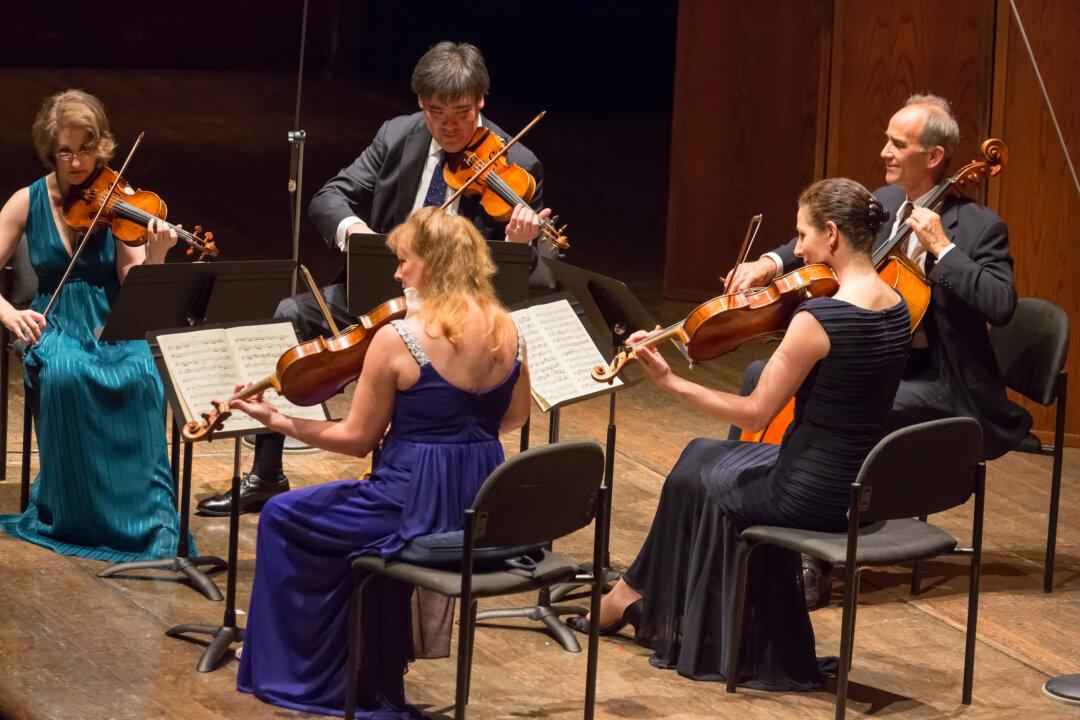NEW YORK—If Joshua Bell is known for the sweetness of his tone, and Sarah Chang is remembered for the strength in her sound, we could say that Sheryl Staples brings both qualities to her playing: her tone is one with a strong core, coated by softer, feminine elegance. Her performance was so enchanting that we could forget she was just stepping in last minute for an injured violinist.
Sheryl Staples is the Principal Associate Concertmaster of the New York Philharmonic, who took the plunge when renowned violinist Lisa Batiashvili announced last minute that she could not perform due to muscular problems in her right arm and shoulder.
And that is the magic of the New York Philharmonic. It never ceases to surprise you even if they are playing age-old classics; in fact, they move you precisely because of their continuation of the classics.
On June 8, The New York Philharmonic quintet played the Brahms String Quintet No. 2 in G Major, Op. 111.
There is no other sound quite like the richness of a classical harmony played by not only talented, but veteran musicians.
The ensemble members included Cynthia Phelps, the Philharmonic’s Principal Viola; violist Rebecca Young who joined the New York Philharmonic in 1986 as its youngest member; the philharmonic’s Principal Cello Carter Brey; Staples; and the one and only Alan Gilbert playing violin counterparts.
It was a change of pace to watch the celebrated conductor return to his first love—the violin.
The ensemble captured the intensity of the opening notes, with vast, synchronized crescendo and decrescendo tremolos.
According to the New York Philharmonic website, as Brahms was sending this very string quintet to his publisher in 1890, he also sent a note saying “The time has now come for you to say good-bye to any further compositions from me.”
The note showed that Brahms was facing an internal conflict when creating this piece. Though he did continue to compose masterpieces for another decade.
The New York Philharmonic quintet did a dynamic job conveying this powerful moment of history; they seemed to capture the intensity of Brahms’s internal struggles when he composed the quintet.
During the second half, the whole New York Philharmonic gathered to play Tchaikovsky’s Symphony No. 6, “Pathétique.” The name “Pathétique” means emotional, not pathetic.
Tchaikovsky once described the piece as a program that “will be left as an enigma—let people guess it for themselves. [It] is so intensely personal that as I was mentally composing it, I frequently wept copiously,” according to the New York Philharmonic website.
In 1892, before Tchaikovsky began writing the symphony’s notes on manuscript, he jotted down ideas for the movements. He wrote in notes that he wanted the piece to capture “the ultimate essence of the thirst for activity,” according to the New York Philharmonic.
The second movement was originally supposed to be about love; the third, disappointment, and the fourth ends with the act of dying away.
Despite the initial intention was for the piece, Tchaikovsky seemed to find hope in life as he was writing the final version, and it was this “thirst for activity,” or life, that truly came through during the New York Philharmonic performance.
From their powerful brass section, to the full on forte fortissimo of the strings, the orchestra conveyed a sense of celebration of life and all the potential achievements a human being can reach within a life time.
Tchaikovsky conducted the premiere of “Pathétique” nine days before his death.
At the end of the incredibly moving performance, Gilbert turned around to face the audience. He did not look proud; instead, he had the look of a man who had just given a part of the essence of his heart—to not only the orchestra, but the listeners. He looked happy, and slightly weary, as if had just been fighting to understand and convey what Tchaikovsky had meant to say.
New Lives Embrace Classical Music
The last surprise of the evening was another “thirst for activity,” the thirst to maintain classical music activities for future generations.
There was a post-concert performance by individuals of the New York Philharmonic who played songs composed by the Very Young Composers.
Credit Suisse Very Young Composers is a series of after school programs around the world that exposes students to orchestral instruments and composition.
The program was developed by Jon Deak, noted composer and former New York Philharmonic Associate Principal Bass.
The young composers were in elementary and middle school. Young composers from New York included Jake O'Brien, Charlotte Pinney, Julia Arancio, Elli Choi, and Austin Celestin.
International young composers included Alejandro Zarzuelo from Spain, Max and Sam Baraitser-Smith from England, and Arttu Jauhiainen from Finland.
Zarzuelo composed a piece with movements to symbolize a child who is panicking because he is late for school, followed by a calm movement when he successfully arrives on time, followed by another movement he becomes bored in class, and ends with an exhilarating note to symbolize the end of a school day.
The young composers wrote every note, including the orchestration.





